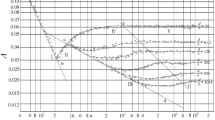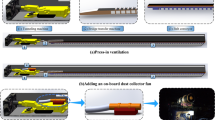Abstract
The special linear shape of spiral tunnel changes the air flow structure during tunnel construction and changes the diffuse and distribution of blasting dust. Mastering the blasting dust distribution and diffuse mechanisms can provide theoretical basis for ventilation layout and dust removal measures during spiral tunnel construction. To study the influence of spiral shape on dust diffusion and concentration distribution after tunnel blasting, a similar scale model of 1:20 and full-scale numerical model of spiral tunnel during construction were established. The similarity criterion and the similarity ratio of each physical quantity are derived from the dust motion equation. The dust distribution and diffuse characteristics in the spiral tunnel under different dust release quantity and release velocity were studied by model experiment. The dust distribution and diffuse characteristics in spiral tunnel with different curvature radius were studied by numerical simulation. The dust distribution model is refined based on the research results. The dust distribution model divides the tunnel into heavily polluted area and slightly polluted area, and the influence characteristics of the curvature radius on the dust export area are found. The layout of ventilation systems can be optimized according to the volume of heavily polluted areas. The heavily polluted area should be as small as possible; the dust in the heavily polluted area should be discharged to the slightly polluted area in an orderly manner to avoid the accumulation of dust. Dust removal measures can also be arranged according to the dust export location to improve dust removal efficiency.














Similar content being viewed by others
Data availability
All data generated and analyzed during our study are included in this article.
References
Azam S, Mishra DP (2019) Effects of particle size, dust concentration and dust-dispersion-air pressure on rock dust inertant requirement for coal dust explosion suppression in underground coal mines. Process Saf Environ Prot 126:35–43
Brosh T, Kalman H, Levy A (2014) Accelerating CFD-DEM simulation of processes with wide particle size distributions. Particuology 12:113–121
Cai XJ, Nie W, Yin S, Liu Q, Hua Y, Guo LDA, Cheng L, Ma QX (2021) An assessment of the dust suppression performance of a hybrid ventilation system during the tunnel excavation process: numerical simulation. Process Saf Environ Prot 152:304–317
Chen XF, Guo C, Song JX, Wang X, Cheng JH (2019) Occupational health risk assessment based on actual dust exposure in a tunnel construction adopting roadheader in Chongqing, China. Build Environ 165:106415
Fan L, Liu SM (2021) Respirable nano-particulate generations and their pathogenesis in mining workplaces: a review. Int J Coal Sci Technol 8:179–198
Fang Y, Fan JG, Kenneally B, Mooney M (2016) Air flow behavior and gas dispersion in the recirculation ventilation system of a twin-tunnel construction. Tunn Undergr Sp Tech 58:30–39
Feng XJ, Wang P, Liu SF, Wei H, Miao YL, Bu SJ (2022) Mechanism and law analysis on ground settlement caused by shield excavation of small-radius curved tunnel. Rock Mech Rock Eng 55:3473–3488
Geng F, Luo G, Wang YC, Peng ZB, Hu SY, Zhang TT, Chai HL (2018) Dust dispersion in a coal roadway driven by a hybrid ventilation system: a numerical study. Process Saf Environ Prot 113:388–400
Guo Q, Ren WX, Shi JT (2019) Foam for coal dust suppression during underground coal mine tunneling. Tunn Undergr Sp Tech 89:170–178
Hua Y, Nie W, Liu Q, Yin S, Peng HT (2020) Effect of wind curtain on dust extraction in rock tunnel working face: CFD and field measurement analysis. Energy 197:117214
Hua Y, Nie W, Guo LD, Xj C, Cheng L (2021) The control effect of 3D spiral wind-curtain generator on respirable dust pollution during tunnelling process. Environ Sci Pollut Res 28:68212–68228
Jiang W, Xu XY, Wen ZH, Wei L (2021a) Applying the similarity theory to model dust dispersion during coal-mine tunneling. Process Saf Environ Prot 148:415–427
Jiang ZA, Wang YP, Men LG (2021b) Ventilation control of tunnel drilling dust based on numerical simulation. J Cent South Univ 28:1342–1356
Li QZ, Wang K, Zheng YN, Ruan ML, Mei XN, Lin BQ (2016) Experimental research of particle size and size dispersity on the explosibility characteristics of coal dust. Powder Technol 292:290–297
Li SH, Zhou FB, Wang F, Xie B (2017) Application and research of dry-type filtration dust collection technology in large tunnel construction. Adv Powder Technol 28:3213–3221
Li HH, Liu JH, Ge JW (2020) Phenomenological characteristics of continuous spill fires in a tunnel with longitudinal ventilation. Process Saf Environ Prot 138:108–116
Lin F, Liu R, Zhang ZG, Jiang DY, Chen JH, Li Y (2022a) Reduction of blasting induced ground vibrations using high-precision digital electronic detonators. Front Earth Sci 9:804504
Lin S, Liu ZT, Wang ZR, Qian JF, Gu ZJ (2022b) Flame characteristics in a coal dust explosion induced by a methane explosion in a horizontal pipeline. Combust Sci Technol 194:622–635
Liu Q, Nie W, Hua Y, Peng HT, Ma H, Yin S, Guo LD (2019a) Long-duct forced and short-duct exhaust ventilation system in tunnels: formation and dust control analysis of pressure ventilation air curtain. Process Saf Environ 132:367–377
Liu R, Ren S, Fan JY, Wu F, William NT (2019b) The air-flow structure and gas dispersion behavior in gas tunnel construction through bench cut method. Therm Sci 23:1417–1424
Liu Q, Nie W, Hua Y, Yin S, Guo LD, Peng HT, Ma H, Zhou WJ (2020a) Investigation of efficient dust control strategy for construction tunnels: ventilation system’s implications for cleaner production. Build Environ 180:107032
Liu R, He Y, Zhao YF, Jiang X, Ren S (2020b) Tunnel construction ventilation frequency-control based on radial basis function neural network. Autom Constr 118:103293
Liu CQ, Bao Q, Nie W (2022) The influence of ventilation parameters on dust pollution in a tunnel's environment using the CFD method. J Wind Eng Ind Aerod 230:105173
Luo QM, Huang LP, Xue XY, Chen ZS, Zhou FB, Wei LH, Hua JM (2021) Occupational health risk assessment based on dust exposure during earthwork construction. J Build Eng 44:103186
Ma LH, Jiang X, Chen J, Zhao YF, Liu R, Ren S (2021) Analysis of damages in layered surrounding rocks induced by blasting during tunnel construction. Int J Struct Stab Dyn 21:2150089
Ma LH, Lin F, Liu R, Liu P, Xia G, Chen LC (2022) Disturbance and control of national strategic gas storage induced by adjacent tunnel blasting. Front Earth Sci 9:807073
Miller RL, Cakmur RV, Perlwitz J, Geogdzhayev IV, Ginoux P, Koch D, Kohfeld KE, Prigent C, Ruedy R, Schmidt GA (2006) Mineral dust aerosols in the NASA Goddard Institute for Space Sciences ModelE atmospheric general circulation model. J Geophys Res Atmos 111:D06208
Nie W, Cheng L, Yin S, Liu Q, Hua Y, Guo LD, Cai XJ, Ma QX, Guo C (2022) Effects of press-in airflow rate and the distance between the pressure duct and the side wall on ventilation dust suppression performance in an excavating tunnel. Environ Sci Pollut Res 29:19404–19419
Peng HT, Nie W, Yu HM, Cheng WM, Bai P, Liu Q, Liu ZQ, Yang SB, Xu CW, Hua Y, Guo C, Ma QX (2019) Research on mine dust suppression by spraying: development of an air-assisted PM10 control device based on CFD technology. Adv Powder Technol 30:2588–2599
Perera IE, Sapko MJ, Harris ML, Zlochower IA, Weiss ES (2016) Design and development of a dust dispersion chamber to quantify the dispersibility of rock dust. J Loss Prev Process Ind 39:7–16
Reed WR, Zheng Y, Yekich M, Ross G, Salem A (2018) Laboratory testing of a shuttle car canopy air curtain for respirable coal mine dust control. Int J Coal Sci Technol 10:1007
Ren WX, Shi JT, Guo Q, Zhao QK, Bai L (2017) The influence of dust particles on the stability of foam used as dust control in underground coal mines. Process Saf Environ Prot 111:740–746
Shao T, Hu Y, Wang W, Jin Y, Cheng Y (2013) Simulation of Solid Suspension in a Stirred Tank Using CFD-DEM Coupled Approach. Chinese J Chem Eng 21:1069–1081
Song YF, Zhang Q, Wu WW (2017) Interaction between gas explosion flame and deposited dust. Process Saf Environ Prot 111:775–784
Wang F, Wang MN, Wang QY (2012) Numerical study of effects of deflected angles of jet fans on the normal ventilation in a curved tunnel. Tunn Undergr Sp Tech 31:80–85
Wang F, Wang MN, Carvel R, Wang Y (2017) Numerical study on fire smoke movement and control in curved road tunnels. Tunn Undergr Sp Tech 67:1–7
Wei QX, Zhang YS, Chen K, Liu B, Meng XB, Zhang XY, Chen HY, Chen JS (2021) Preparation and performance of novel APP/NaY-Fe suppressant for coal dust explosion. J Loss Prev Process Ind 69:104374
Xu CW, Nie W, Liu ZQ, Peng HT, Yang SB, Liu Q (2019) Multi-factor numerical simulation study on spray dust suppression device in coal mining process. Energy 182:544–558
Xu CW, Nie W, Yang SB, Peng HT, Liu ZQ, Ma QX, Guo C, Liu Q (2020) Numerical simulation of the multi-index orthogonal experiments on the spray dust-settling devices. Powder Technol 371:217–230
Yu HM, Cheng WM, Wu LR, Wang H, Xie Y (2017) Mechanisms of dust diffuse pollution under forced-exhaust ventilation in fully-mechanized excavation faces by CFD-DEM. Powder Technol 317:31–47
Zender CS, Bian H, Newman D (2003) Mineral Dust Entrainment and Deposition (DEAD) model: description and 1990s dust climatology. J Geophys Res 108:D14
Zhang C, Wang C, Niu XB, Zhang SQ, Zhao HL (2020) Effect of the double-line spiral tunnel curvature on the tunnel construction stability. Adv Civ Eng 2020:8827806
Zhang HQ, Liu R, Chun JW, Xue QW, Fan JY (2022) Study on optimization of the dedusting air duct layout in coal mine roadway. Front Earth Sci 10:855438
Funding
This work was supported by State Key Laboratory of Coal Mine Disaster Dynamics and Control (2011DA105287-MS202122) and Chongqing Science and Technology Bureau (CSTB2022NSCQ-MSX1595).
Author information
Authors and Affiliations
Contributions
All authors contributed to the study conception and design. Material preparation, data collection and analysis were performed by RL, DJ, YH and SR. The first draft of the manuscript was written by RL, JC and JF. All authors commented on previous versions of the manuscript. All authors read and approved the final manuscript.
Corresponding author
Ethics declarations
Ethics approval
Not applicable.
Consent to participate
Not applicable.
Consent for publication
Not applicable.
Competing interests
The authors declare no competing interests.
Additional information
Responsible Editor: Philippe Garrigues
Publisher's note
Springer Nature remains neutral with regard to jurisdictional claims in published maps and institutional affiliations.
Rights and permissions
Springer Nature or its licensor (e.g. a society or other partner) holds exclusive rights to this article under a publishing agreement with the author(s) or other rightsholder(s); author self-archiving of the accepted manuscript version of this article is solely governed by the terms of such publishing agreement and applicable law.
About this article
Cite this article
Liu, R., Jiang, D., Chen, J. et al. Blasting dust diffuse characteristics of spiral tunnel and dust distribution model: similar experiment and numerical modeling. Environ Sci Pollut Res 30, 52340–52357 (2023). https://doi.org/10.1007/s11356-023-25422-w
Received:
Accepted:
Published:
Issue Date:
DOI: https://doi.org/10.1007/s11356-023-25422-w




